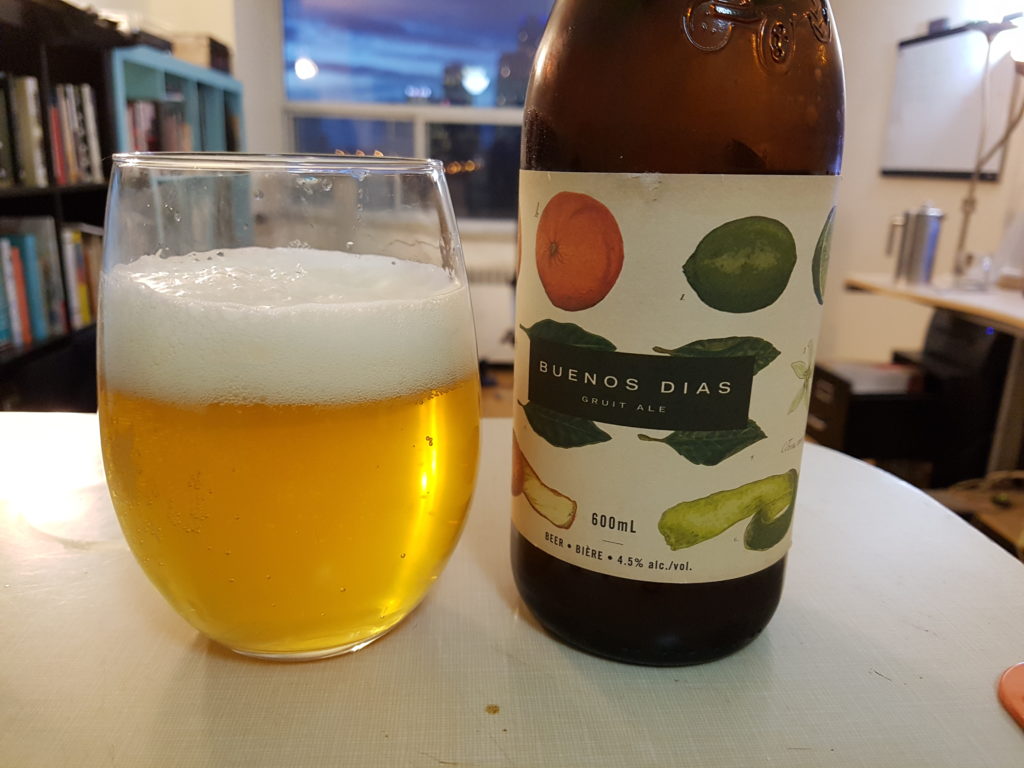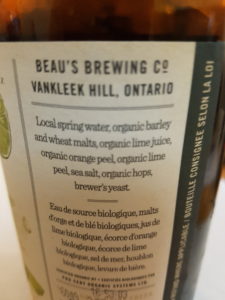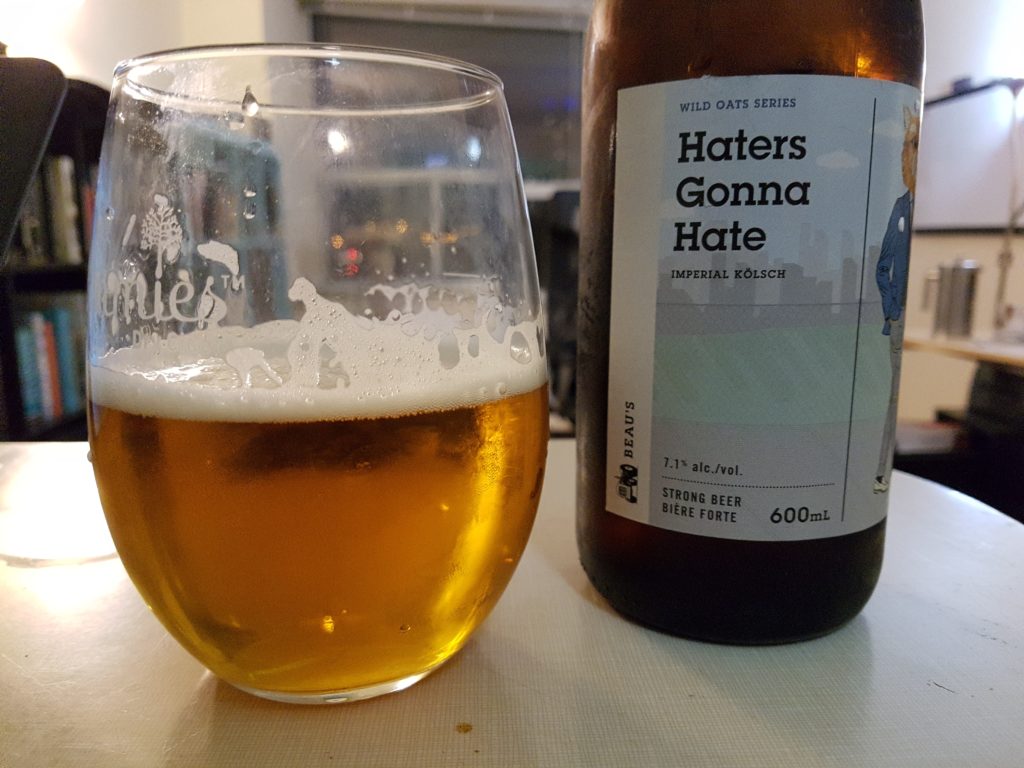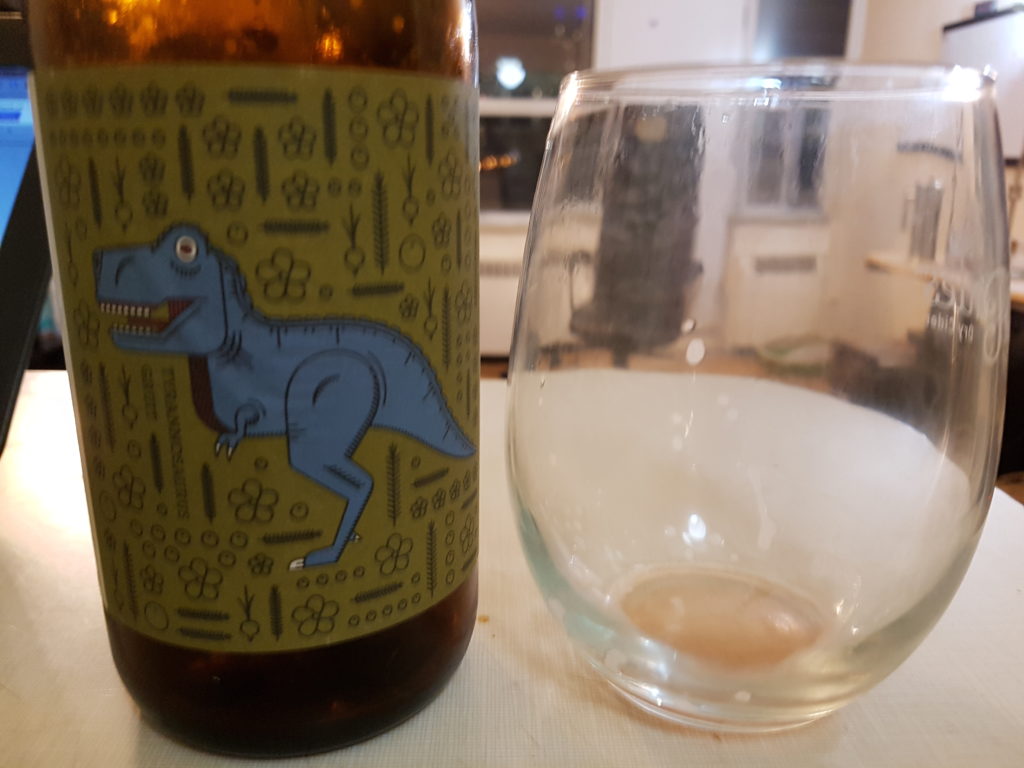Of all the people who send beer out for review, Beau’s is probably the most prolific. It’s nice that they basically send one of everything for review, but a lot of the time there’s so much going on in Ontario that I worry reviewing all of it might give people the impression that I was somehow in their pocket. I have collaborated with them on a couple of beers, (including the Margaret Atwood one which was in the LCBO), but I’m actually one of their most vociferous critics.
Don’t get me wrong. I have liked basically everyone I’ve met that works for Beau’s. I like their corporate culture, I like their green initiatives. I’m not sure I got the specific reasoning behind the Rwanda project, but it was a nice thing to do. I like the community they’ve got going amongst their staff who might as well be a tribe at this point. They’ve got a heck of a lot going for them, including the best branding in the business and a can do attitude. Also, the packaging on their bottles is the exact size and shape of styrofoam I need to install and insulate the air conditioner for the summer. Useful!
From a product development standpoint, the can do attitude sometimes gets them into trouble. For a brewery whose biggest seller is a fairly straightforward lagered ale made with organic ingredients, they seem to have something else coming out every week. Think for a moment about what they’re releasing. There’s the Wild Oats Series, the Gruit Series, the Canada 150 series of collaborations, the Farm Table Series, and I’m sure I’m missing a trick. Collective Arts recently launched a beer a week for a month. My reaction was, “bit late to the party. Beau’s hasn’t missed a week in something like two years.”
Now I can’t imagine that the lay-consumer sees all of this coming to shelves. I barely do. I went to a beer dinner in the winter for a beer that wasn’t going to exist in about a week’s time. It was an interesting beer. I had a lovely time. I’m not sure what I was meant to do with the information.
This is the thing I’ve noticed and periodically spoken up about: the ideas may be interesting, but I feel like the rush to produce so many different things probably reduces the lead time and R&D on each product. That some should be better than others is no real surprise. The Farm Table series seems to be an attempt to rein it back and focus in a little, but there’s still a beer a week on average.
Let’s review the current crop of things in my fridge and see if I can illustrate the point.
BUENOS DIAS GRUIT ALE
This is a beer that I have a problem with from a conceptual standpoint. What does everyone know about Gruit? Gruit was a mix of herbs and spices distributed by the church to flavour ale before hops came into vogue. Let’s look at the ingredients. Local spring water, organic barley and wheat malts, organic lime juice, organic orange peel, organic lime peel, sea salt, organic hops, brewer’s yeast.
It’s got hops and fruit in it, but nary an herb or spice. Probably not a gruit then. It’s also got a lot of citrus flavour and sea salt in it. It’s pretty clearly trying to capitalize on both the Margarita and the Gose, (a lesser known Bulgakov novel to be sure). Why prevaricate? Call a Gose a Gose if that’s what it is.
From an aromatic standpoint it does the vaguely soapy thing that citrus pith sometimes does. There’s something of the ossified clementine in the mid January fruit bowl about it. The odd thing is that coriander probably would have helped, as it needs something to break up the fairly one dimensional citrus blanket on the palate. To be a proper Gose it would need that and a lower PH. To be a Margarita it would also benefit from more acid and more rim salting punch. It seems like an odd compromise between a number of different conceptual directions and that lands it in unsuccessful territory from my point of view.
That leads us nicely into:
HATERS GONNA HATE
This is one they stumbled across accidentally. It’s based on a brew of their original Lagered Ale that ended up stronger than it was meant to be because of equipment difficulties. One of the problems that Beau’s faces in brewing traditional styles of beer is that it’s quite difficult to get organic hops. For some reason, New Zealand seems to be a world leader in that department, so a lot of Beau’s non traditional beers end up with tropical fruit and minerality.
Oddly enough, this is exactly the kind of thing that I hear European craft brewers are doing. Playing around with the base model of a beer and switching out a single ingredient. Czech Pilsners with Australian hops? Interesting. Kolsch works for this because the flavours are meant to be fruity and floral. A lot of Kolsch develops orchard fruits or white grape or grape nut grain character, so switching out one fruity note for another is entirely sensible. In this case, papaya, white grape, and possibly a touch of dragon fruit.
If you weren’t told what it was or what was in it, I think you’d have difficulty guessing, but the flavour profile is simple enough and makes enough sense that it works in a concrete fashion. The depth of bitterness is also well judged. Any more and it would over power it.
Let’s shake that off and move on to:
TYRANNOSAURUS GRUIT
Cue Lisa Simpson: WE GOT BEETS!
Gruit is weird. I’ve had some I really like. Jopen, for instance, makes a wonderful classic version of gruit.
This is a new world interpretation. I’m down on new world gruits despite having conceptualized one based on Oryx and Crake, and I’ll tell you why: historically beer tends to be borne out of necessity. The original gruit mixture, which is closer to something like you get in Beau’s Bog Water was sort of what was available. This seems to me like a random agglomeration of ingredients. If you’re chowing down on a beet salad, I bet you’ve never said “this could use spruce!” If you’re drinking a juniper heavy G&T I could see throwing in a hibiscus flower to enhance the aroma, but no one is sitting around asking the waitress for a wedge of beet. I would bet this is the only product in the world with this combination of ingredients and I bet that if you asked a random passer by to guess what they were you’d get stunned confusion in re: at least three of them. A new world thinker once said it while sitting next to a pond: simplify, simplify.
I think it’d be easier to get behind if you took a combination of two of these four things. Beetroot and Hibiscus? It sort of works! Juniper and Spruce? Practically already a Finnish gruit. Hell, Juniper and Hibiscus! That’d work. This is muddy. You get the beetroot sweetenss and the hibiscus flower up front and it works, but then the spruce and juniper cut in and it becomes claggy and the initial impression of a lovely jammy fruity thing turns into a lingering, palate coating quagmire and a spruce needle lodged in the throat. It’s over the line from complexity to achieve a purpose and into complexity just because.
Coco Chanel it. Look in the mirror and take off two things.
Finally:
BLACKSTRAP BOOTSTRAPPER
Part of the Ottawa 150 series, this is a collaboration with Crannog Ales. That’s fun, because I’ve never tried a Crannog beer before. They are hyper local and organic and as such I don’t recall them submitting anything to the Canadian Brewing Awards during my tenure.
It’s very good. Blackstrap Molasses has been a brewing ingredient since way back. Enough fermentable sugar to make booze, enough unfermentable nasties to take you to funkytown flavorwise. The best thing I can say about this beer is that it reminds me of cookies my college roommate’s grandmother served us one day in Lake Placid. The only deficiency here is that it could use a little more body. The sugar has been carved right out of the wort and as a result the effect is something like a hollow tube. The molasses plays around the edges of the cylinder, but never quite manages to completely assert itself. Still good though. Can’t take anything away from it.
Let’s sum up:
The best beer here is the one that was originally a mistake and which has been rebrewed several times. They’ve worked at it over the years and HATERS GONNA HATE is absolutely worth your time. Give it a go. The second best is a collaboration using traditional ingredients. The Ottawa 2017 series is going to produce a lot of competent collaborations. Blackstrap Bootstrapper is worth trying if you see it out and about. BUENOS DIAS is probably for you if you like citrus heavy Witbiers and can get past the conceptualization. TYRANNOSAURUS GRUIT can beet its feet back to the Cretaceous period.





Crannog. All I can say is you, as a beer critic, have to try their mainstay Back Hand Of God. It will ruin you for any other Irish stout. I’d call it a template for the style, very balanced, no goofy diversions.
Also, I recall being at the Railway Club in Vancouver (sadly defunct) and someone (I believe an owner) from Crannog was delivering and checking lines. I made a crack about how I’ve seen Ken from Black Oak back home in Toronto be so hands on and he immediately had a pint pulled for me and sat down to discuss the community in Toronto out of interest. When I explained I was not all that connected but I was interested in their story, I got a short discussion about their hop farm and an invite to visit. I was not in a position to take up the invite at the time. But I have had a few people in the Vancouver beer scene comment that these are simply the nicest people in the business, which says a lot in a business full of nice people.
I suggest you contact them for some review samples. I would not be surprised if they personally delivered them.